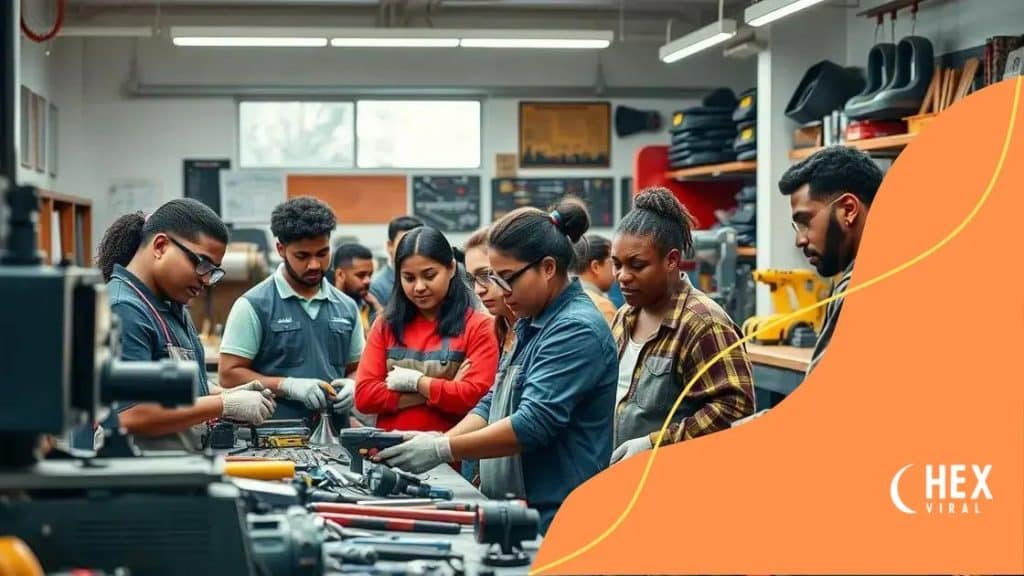Tuition-free trade school initiatives: a game changer

Tuition-free trade schools provide accessible vocational education, allowing students to gain in-demand skills without incurring debt, effectively preparing them for successful careers in various industries.
Tuition-free trade school initiatives are transforming the landscape of education and skills training. Have you ever thought about how accessible these opportunities could be for you or someone you know? Let’s dive into what these initiatives entail.
Understanding tuition-free trade schools
Understanding tuition-free trade schools is essential for anyone considering vocational education options. These institutions offer an opportunity to gain valuable skills without the burden of student debt. With programs tailored to meet workforce demand, they provide students with the tools they need to succeed.
Tuition-free trade schools focus on equipping students with practical skills in various fields. These can range from healthcare and technology to construction and culinary arts. The key benefits include skilled training, industry connections, and job placement assistance.
Key Features of Tuition-Free Trade Schools
Many of these schools have unique features that make them appealing:
- No tuition fees: Students can access training without paying out of pocket.
- Hands-on experience: Programs often include practical training that prepares students for real-world jobs.
- Flexible schedules: Many schools offer evening and weekend classes to accommodate working students.
- Career services: Support in job placement and resume building is frequently available.
In addition to these features, tuition-free trade schools often partner with local businesses. This ensures that students receive training in skills that are in high demand. Graduates frequently find employment quickly, as their training aligns closely with job market needs.
Moreover, many people may not realize that financial aid and government grants support these programs. This means that even students who need extra help can still attend without incurring debt. Some programs even provide living stipends for low-income individuals.
Overall, understanding the value of tuition-free trade schools can help you make an informed decision about your educational path. These schools represent a viable option for many looking to build a career without the financial struggles that often accompany traditional education.
Benefits of tuition-free trade school initiatives
The benefits of tuition-free trade school initiatives are significant for students seeking practical education. These programs provide essential skills without the financial burden of tuition, making education more accessible for everyone.
By enrolling in a tuition-free trade school, students can gain a fast track to employment. The training offered is often directly aligned with current industry needs, ensuring a better job placement rate post-graduation. Students emerge with hands-on experience and the specific skills that employers are looking for.
Key Advantages
Several advantages stand out when considering these initiatives:
- No student debt: Graduates leave with their skills intact and without the stress of loan repayment.
- Job readiness: Programs focus on practical training and real-world applications, preparing students for immediate employment.
- Networking opportunities: Connections with local businesses can lead to internships and job placements.
- Diverse programs: Tuition-free trade schools offer a variety of fields, from healthcare to technology and beyond.
This model also helps bridge skill gaps in various sectors. By training students in specific areas, these schools directly contribute to local economies. They not only help individuals but also enhance workforce development.
In addition, many of these programs provide additional support services. From career counseling to resume workshops, students are equipped with the necessary tools for success in the job market. Many also offer flexible schedules, making it easier for working adults to pursue education without disrupting their lives.
Ultimately, the benefits of tuition-free trade school initiatives create a win-win scenario for students and employers alike. By lowering barriers to education while fostering a skilled workforce, these programs are shaping a brighter future for many.
Success stories from students

Success stories from students in tuition-free trade school initiatives highlight the impact of these programs on real lives. Many individuals have transformed their futures through education that is accessible and affordable. These stories serve as inspiration for prospective students.
For example, consider a student who entered a culinary program at a tuition-free trade school. After completing her training, she quickly found a job in a local restaurant as a chef. Her skills allowed her to climb the ranks in the kitchen, and now she runs her own food truck, sharing her passion with the community.
Real-Life Transformations
These success stories show how tuition-free programs can change lives:
- Career advancement: Many graduates report promotions and increased salaries shortly after finishing their courses.
- Business ownership: Some students have used their education to open businesses, providing jobs in their communities.
- Skill acquisition: Graduates gain practical skills that are directly applicable to the job market.
- Networking successes: Connections made during training often lead to valuable job offers.
Another inspiring story involves a man who studied automotive repair at a tuition-free trade school. He began as an apprentice and soon became a fully certified technician. His drive and dedication paid off as he landed a job at a prestigious dealership, significantly improving his quality of life.
These accounts underscore the importance of accessible education. Students who may have felt constrained by financial limitations are now thriving in their chosen fields. By focusing on practical skills and real-world applications, tuition-free trade schools empower individuals to pursue their passions and achieve their goals.
Ultimately, the success stories from students in these programs reveal the potential inherent in tuition-free trade schools. They not only equip students with skills but also help them build fulfilling careers and lives.
How to apply for these programs
Applying for tuition-free trade school programs can seem daunting, but it’s a straightforward process. Many students find it easier to navigate once they understand the key steps involved. By following these clear instructions, anyone can start their journey toward skill development.
The first step is to research available programs. Numerous tuition-free trade schools exist across the country, each offering different courses and specialties. It’s important to find a program that aligns with your career goals and interests.
Steps to Apply
Here are the main steps to apply successfully:
- Gather necessary documents: This may include proof of residency, identification, and transcripts from previous education.
- Complete the application form: Visit the school’s website to fill out the application. Make sure to double-check for any specific instructions.
- Write a personal statement: This is your opportunity to explain why you want to join the program and how it aligns with your future goals.
- Submit your application: Follow the submission guidelines carefully, whether it’s online or in-person.
Many trade schools also require an interview. This is your chance to show your enthusiasm and commitment. Preparing for potential interview questions can improve your chances of acceptance. Additionally, don’t hesitate to ask for assistance during this process. Schools often have advisors who can help guide you.
Applying for financial aid is another important step. Many programs have scholarships, grants, or stipends available. Completing the Free Application for Federal Student Aid (FAFSA) can open doors to additional funding. Understanding all available options ensures that you are not only applying for the program but also finding ways to support your education financially.
Overall, the application process for tuition-free trade school initiatives is designed to be accessible. By preparing adequately and knowing what to expect, students can increase their chances of being accepted into their desired programs.
Future of vocational education
The future of vocational education looks bright as more students and employers recognize its value. With the rise of technology and shifting job markets, vocational programs are evolving to meet new demands. These changes ensure that students are equipped with the skills they need for success.
One major trend is the integration of technology in trade training. Virtual reality, online courses, and simulation tools are becoming common in many programs. Students can gain practical experience in a safe and controlled environment. This approach enhances learning and prepares them for real-world applications.
Changing Industry Needs
As industries change, vocational education must adapt. Several key areas are growing:
- Green jobs: As society shifts towards sustainability, skills in renewable energy and green technologies are increasingly important.
- Healthcare demand: Many healthcare fields need trained professionals, and vocational education offers quick paths into these roles.
- Technology skills: Fields such as IT and digital marketing are expanding, requiring vocational programs to teach relevant skills.
- Soft skills training: Employers value communication, teamwork, and problem-solving skills, leading programs to incorporate these areas into their curricula.
Moreover, partnerships between trade schools and businesses are becoming more common. These collaborations ensure that training programs match the requirements of employers. Internships, apprenticeships, and job placement services are included in many programs to enhance student opportunities.
Another significant aspect is the increasing awareness of tuition-free trade schools. People are now recognizing the importance of vocational education without the burden of debt. More initiatives are emerging to support access to these programs, making education a reality for many.
In conclusion, the future of vocational education seems promising as it evolves with industry changes. By focusing on partnerships, modern training methods, and important skill sets, vocational programs will continue to play a critical role in preparing the workforce of tomorrow.
Tuition-free trade schools are changing lives by providing accessible education and relevant skills. With hands-on training, students are prepared for rewarding careers in various industries. As these programs evolve, they focus on industry needs, ensuring graduates are job-ready. Partnerships with businesses enhance opportunities, making vocational education a practical choice for many. Ultimately, the future looks promising as more people recognize the value of skills training without financial burdens.
FAQ – Frequently Asked Questions about Tuition-Free Trade Schools
What are tuition-free trade schools?
Tuition-free trade schools offer vocational training programs without requiring students to pay tuition fees, making education more accessible.
What types of programs are available at these schools?
These schools offer a variety of programs including healthcare, automotive, technology, culinary arts, and many others tailored to workforce needs.
How can I apply for a tuition-free trade school program?
To apply, you need to research available programs, gather necessary documents, complete the application form, and may need to write a personal statement.
What are the benefits of attending a tuition-free trade school?
Benefits include no student debt, hands-on training, strong job placement rates, and the ability to acquire in-demand skills tailored to current industry needs.






